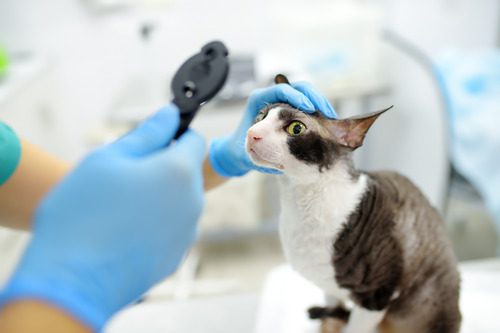Eye discharge in cats is a common concern that can range from mild and temporary to a sign of something more serious. Cat eye discharge can appear watery, sticky, or thick, and while some cases are harmless, others may point to underlying conditions that require veterinary attention. Knowing why cat eye discharge develops and how veterinarians approach treatment can help you protect your cat’s comfort and health.

Why Cat Eye Discharge Happens
Cats may develop eye discharge for a variety of reasons. Some cases are related to normal tear production and debris buildup, while others are linked to infections, injuries, or chronic conditions. Cat eye discharge becomes a concern when it is persistent, changes in appearance, or is accompanied by other signs like redness, swelling, or squinting.
When you notice cat eye discharge, it’s important to monitor how much is present, what it looks like, and whether your cat seems irritated. These details can help your veterinarian at Millis Animal Hospital determine the most likely cause and recommend the best course of action.
Causes of Cat Eye Discharge
Several conditions can lead to cat eye discharge, each with its own appearance and symptoms.
Conjunctivitis
Conjunctivitis, often called “pink eye,” is one of the most common causes of cat eye discharge. It occurs when the conjunctiva, the delicate tissue around the eye, becomes inflamed. Cats with conjunctivitis may develop red, swollen eyes along with watery or thick discharge. The discharge may appear clear in mild cases or yellowish-green when infection is involved.
Upper Respiratory Infections
These infections are often caused by viruses like feline herpesvirus or calicivirus. Along with cat eye discharge, you may notice sneezing, nasal discharge, and reduced appetite. Kittens and shelter cats are especially prone to these infections, though any cat can be affected.
Allergies
Just like people, cats can develop allergies to environmental triggers such as pollen, dust, or cleaning products. Allergies can cause watery cat eye discharge along with itchiness and sneezing. The discharge is usually clear but may become more noticeable during high allergy seasons.
Injuries or Foreign Bodies
A scratch on the cornea or a small object lodged in the eye can lead to irritation and cat eye discharge. Cats with an eye injury may squint, paw at their face, or avoid light. Injuries always require veterinary evaluation, as untreated trauma can cause long-term damage.
Blocked Tear Ducts
Cats have tear ducts that normally drain fluid from the eyes. If these ducts become blocked, tears may overflow and cause watery cat eye discharge. This is more common in certain breeds with flatter faces, such as Persians, but it can happen to any cat.
Chronic Conditions
Some cats develop chronic cat eye discharge due to ongoing conditions like feline herpesvirus infections. In these cases, flare-ups may occur periodically, especially during times of stress. While not always preventable, proper veterinary care can help manage symptoms and reduce discomfort.
How Is Cat Eye Discharge Diagnosed?
Because cat eye discharge has many potential causes, diagnosis requires a careful veterinary exam. At Millis Animal Hospital, your veterinarian will begin by gathering your cat’s history, including when the discharge started, what it looks like, and whether other symptoms are present.
A full eye exam may follow, using tools to examine the cornea, conjunctiva, and tear ducts. In some cases, diagnostic tests such as corneal staining, cultures, or tear production measurements are needed to pinpoint the cause. Identifying the exact reason behind cat eye discharge allows your veterinarian to choose the safest and most effective treatment plan.
What Happens After Diagnosis
The treatment for cat eye discharge depends entirely on the cause. Since the condition can stem from infections, allergies, injuries, or chronic issues, your veterinarian will tailor the approach to your cat’s needs.
Infections
If the discharge results from a bacterial infection, antibiotics may be prescribed. Viral infections, such as feline herpesvirus, require supportive care and sometimes medications to help reduce flare-ups.
Allergies
For cats with allergies, treatment may involve minimizing exposure to the allergen and, in some cases, prescribing medications that reduce inflammation and discomfort.
Injuries or Irritations
Eye injuries may require protective treatment and, in some cases, medication to prevent secondary infection. Immediate veterinary evaluation is always recommended if an injury is suspected.
Tear Duct Issues
Blocked tear ducts may need to be flushed or otherwise managed by your veterinarian. In some cats, ongoing management is necessary to reduce recurring discharge. No matter the cause, professional evaluation ensures that your cat receives the right care without risking further irritation or complications.
When to Contact Your Veterinarian About Cat Eye Discharge
It can be difficult for cat owners to know when eye discharge is harmless and when it signals something more serious. In general, contact a veterinarian if you notice:
- Thick, green, or yellow discharge
- Persistent discharge lasting more than a day or two
- Redness, swelling, or squinting
- Signs of pain, such as pawing at the eye
- Discharge in combination with respiratory symptoms
At Millis Animal Hospital, our team can examine your cat, identify the underlying cause, and provide treatment to relieve discomfort. Call 508-376-5317 or schedule an appointment online to get your cat the care they need.
Tips for Preventing Cat Eye Discharge
While not all cases of cat eye discharge can be prevented, some steps may reduce the risk. Keeping your cat up-to-date on vaccinations, reducing stress, and scheduling regular veterinary checkups can help minimize issues. Clean living environments, especially for cats prone to allergies or infections, also play a role in reducing eye problems.
For cats with chronic conditions like feline herpesvirus, your veterinarian may recommend ongoing care strategies that help control flare-ups. Prevention often comes down to proactive veterinary support and attentive home care.
Maintaining Your Cat’s Eye Health
Cat eye discharge is common, but it should never be ignored. Because the causes range from minor irritations to more serious medical concerns, a veterinary exam is the safest way to protect your cat’s vision and comfort. If you’ve noticed cat eye discharge in your pet, the caring team at Millis Animal Hospital is equipped to help. Call 508-376-5317 or request an appointment online to schedule an eye exam. Prompt veterinary attention can bring relief to your cat and peace of mind to you.
Recent Posts
About Us
Millis Animal Hospital is a privately owned AAHA-accredited, Cat-Friendly Certified practice staffed with Fear Free Certified professionals. We know a thing or two about treating pets and their families the way they deserve, with excellent preventive care and surgical services tailored to your individual needs.
